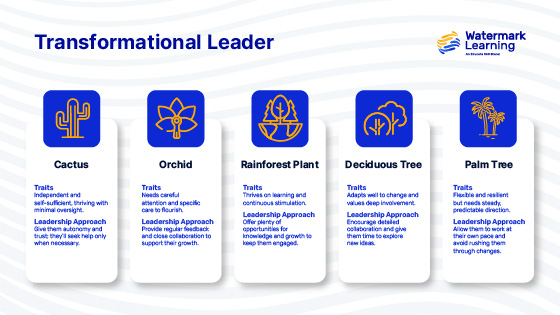How do you define success for your team? Take a moment to think about this question. Consider the leaders in your life—a boss, mentor, teacher, or coach—who have shaped your understanding of what it means to achieve. Did they focus solely on metrics like sales targets or performance ratings? Or did they inspire you to strive for something greater?
Transformational leadership inspires team members to move beyond self-interest and work toward the organization’s greater good. We need leaders who can create a culture of empowerment and continuous improvement. Not transactional leaders who focus on exchanging rewards for performance but transformational leaders who engage their followers by forging meaningful connections and inspiring them to be part of something bigger.
Characteristics of a Transformational Leader
To become a transformational leader requires a shift in mindset from “I can do it” to “We can do it.” Transformational leaders understand the importance of allowing others to take ownership of their work, fostering a collaborative environment where every team member feels valued and empowered. The transformational leadership style requires a few things:
Visionary Thinking: Transformational leaders focus on long-term goals. They’re great at painting a compelling picture of the future, which inspires the team and sparks creativity.
Empathy and Engagement: It’s not about barking orders from the top. These leaders see themselves as part of the team. They invest time in understanding each team member—their strengths, challenges, and what drives them.
Focus on Long-term Solutions: Instead of relying on quick fixes, transformational leaders work to solve underlying issues. Solving underlying issues sets the stage for ongoing success and innovation.
Key Traits of Transformational Leadership
Scholars Bernard Bass and Bruce Avolio identified four key traits—often called the “Four I’s”—that set transformational leaders apart:
1. Idealized Influence
Transformational leaders set the standard for their teams by leading through their actions. They show integrity and consistency, which earns the trust and respect of their team.
2. Inspirational Motivation
These leaders inspire their teams by sharing a compelling organizational vision. Think of Martin Luther King Jr.’s “I Have a Dream” speech—it moved people because it spoke to their deepest hopes and motivated them to take action.
3. Individualized Consideration
A team is rarely a one-size-fits-all group. Transformational leaders take the time to understand their team on a personal level, recognizing their strengths, weaknesses, and motivations. They tailor support to meet individual needs and create an inclusive environment where each team member can thrive.
4. Intellectual Stimulation
Encouraging creativity and innovation is crucial. Transformational leaders challenge the status quo and inspire team members to think critically and explore new ideas.
Transformational vs. Transactional Leadership
Transactional leadership is largely based on exchanges: “If you do this, I’ll reward you with that.” For example, a manager might promise bonuses if a team meets its targets. It’s all about short-term motivation.
On the other hand, the transformational leadership style aligns individual goals with the organization’s overarching mission. Rather than merely rewarding compliance, transformational leaders inspire their team members to develop as individuals and contribute to a shared vision, building up their sense of value and desire to collaborate. For example, on a sales team, a transformational leader wouldn’t just emphasize meeting quotas but work individually with team members to develop their skills in client engagement, product knowledge, and negotiation to highlight their potential.
Why Transformational Leadership Works
Transformational leaders are forward-thinking and future-focused, which helps them create sustainable processes and move companies faster. This forward-looking mindset enables leaders to maximize time and resources, leading to greater efficiency and sustainability.
As important as this strategic thinking is, nearly all the advantages of adopting transformational leadership trace back to its impact on team members’ engagement. Research has consistently shown that transformational leaders generate strong engagement among their teams. This leadership style leads to tangible results as engaged teams are more committed to their work and often go above and beyond. A study by Gallup found that organizations with highly engaged employees experience 18% higher productivity and 23% greater profitability.
Unsurprisingly, leaders who successfully inspire, motivate, and connect with their team members on a personal level are the ones who get the best results. The other benefits of transformational leadership include:
- Lower Turnover Rates: A supportive and inclusive workplace where team members feel they belong leads to less turnover.
- Improved Team Morale and Engagement: Personal connection with team members leads to higher morale.
- Better Long-Term Organizational Success: Ability to inspire innovation and adaptability in team members, contributing to sustained organizational growth.
Industries Where Transformational Leadership Thrives
Transformational leadership tends to thrive in industries that prioritize innovation and adaptability. These sectors require leaders who are forward-thinking and capable of driving continuous improvement.
Technology
Rapid changes, unparalleled competitiveness, and constant market shifts drive the tech industry. Transformational leaders thrive in this environment because they promote creativity and experimentation. Tech is about collaboration and taking risks, and it often brings together cross-functional teams like developers, product managers, designers, and marketing. Technology requires strong teamwork and alignment, something we know transformational leaders are well-suited to.
Healthcare
Transformational leaders focus on painting a shared vision. In healthcare, this often revolves around improving patient outcomes and delivering quality care. By inspiring and motivating their teams with a patient-first mentality, these leaders align everyone to provide the best possible care.
Manufacturing and Supply Chain
Industry 4.0, automation, and data analytics are reshaping the manufacturing and logistics landscape as we know it. As such, these companies need leaders who are well-equipped to guide their teams through these transitions by effectively communicating the benefits of new technologies, providing training, and motivating employees to embrace these changes.
Of course, not every industry is the same. Some are much more conservative, and change requires much longer to implement. Government and education rely more on stability and adherence to established procedures, which limits the opportunities for transformational leadership to take root.
Steps to Transition from Transactional to Transformational Leadership
Step 1: Move from Transactional to Servant Leadership
Servant leadership emphasizes understanding and building strong relationships with your team members. Spend more time with your team, focusing on empathy, human connection, and understanding their needs. Transformational leaders cultivate this environment by actively listening and engaging, building trust, and creating an inclusive workplace that meets team members’ basic needs, such as safety and belonging.
Step 2: Transition to Transformational Leadership
Once trust and strong relationships are established, the next step is to let go of tasks and focus on future-oriented goals. This shift allows leaders to delegate tasks more effectively and empower team members to take ownership of their work. Emphasize collaboration and collective success, helping your team see how their roles contribute to the larger mission.
Practical Advice for Aspiring Transformational Leaders
To be a transformational leader, you must be able to answer the question “What makes each of my team members thrive?”. Team members are similar to plants: some team members are like cacti—they thrive in autonomy and independence—while others may need more nurturing, like orchids. Recognizing your team members’ strengths and preferences allows you to tailor your leadership approach, enabling each person to grow and contribute effectively.

Here are a few practical transformational leadership tips:
- Open Communication: Let your team know they can share ideas without fear of judgment.
- Celebrate Wins and Learn from Losses: Acknowledge team achievements and use setbacks as learning opportunities.
- Balance Empathy and Vision: Be supportive and keep the team focused on the bigger goals.
What Type of Leader Are You?
If transformational leadership interests you, the time has come to evaluate your leadership style. Consider how you can implement the principles we’ve covered here to bolster engagement, motivation, and morale within your team.
Or, if you need help getting started, consider exploring Watermark Learning’s course Becoming a Transformational Leader. You can take virtual classes led by our expert facilitators, pursue self-paced courses you can take at any time, or participate in group workshops for your whole team to learn together. Develop the skills to inspire change, enhance team performance, and positively impact your organization.
Jay Pugh, PhD
Dr. Jay Pugh is an award-winning leader, author, and facilitator with over 18 years of teaching and training experience. Currently serving as Head of Leadership Growth at Educate 360, he leads a robust team of external and internal facilitators who specialize in developing leadership capabilities within medium and large-scale businesses. His team works directly with business professionals, helping them become more effective leaders in their daily operations.
Dr. Pugh holds a Ph.D. in Instructional Management and Leadership, and his academic contributions include two published articles and a dissertation focusing on various educational topics. His extensive experience and academic background have established him as a respected voice in leadership development and educational management.

 New Horizons
New Horizons
 Project Management Academy
Project Management Academy
 Six Sigma Online
Six Sigma Online
 Velopi
Velopi
 Watermark Learning
Watermark Learning
 Login
Login





 New Horizons
New Horizons
 Project Management Academy
Project Management Academy
 Velopi
Velopi
 Six Sigma Online
Six Sigma Online
 Watermark Learning
Watermark Learning